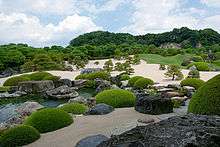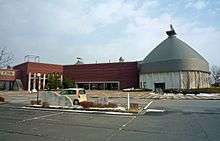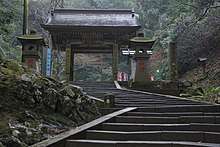Yasugi
Yasugi (安来) is a city at the eastern end of Shimane Prefecture. Directly to the west is the town of Higashi Izumo and then Matsue city. Directly to the east is the city of Yonago (Tottori Prefecture). On October 1, 2004, the towns of Hakuta and Hirose merged with the city of Yasugi. It used to be important for its steel production. It is best known for the comedic yasugibushi dance and as the home to the Adachi Museum of Art.
Get in
By plane
Izumo Airport (出雲空港, IZO) in Izumo to the west, has flights to major Japanese cities and is about 90 minutes away by car. The airport in Yonago, to the east just across the prefectural boundary, is the nearest airport and has a flight to Seoul.
By train
Yasugi is on the San'in Main Line, which runs along western Honshu's Japan Sea coast, starting in Kyoto and passing through Tottori Prefecture on its way to Shimonoseki in Yamaguchi Prefecture.
Get around
- Site seeing map of Yasugi.
- Taxi. There are numerous taxi companies in Yasugi. Taxis can usually be found in front of Yasugi station. Also, as you exit the station, if you turn left and walk about a block you will find a taxi company that is open 24 hours a day. The Yasugi city homepage maintaines a list of taxi companies and their contact information.
See

- 🌍 Adachi Museum of Art (足立美術館), 320 Furukawa-cho, ☎ +81 854-28-7111. Oct-Mar: 9AM-5PM, Apr-Sep: 9AM-5:30PM. Although it is an art museum, Adachi is most famous for its gorgeous 43,000 square meter garden, deemed Japan's best garden by the American Journal of Japanese Gardening for 10 years straight. The gardens are ranked according to how well they utilize sukiya living and there is a bias towards gardens that are less-frequented and less-famous but still well-kept, which is likely why Adachi is consistently number one as museum employees work everyday to make sure it keeps up its appearance (and likely why only Korakuen of the official "top three gardens" has ever broken the list's top 50). However, visitors can only view it through windows inside the museum. The museum itself has a collection of 130 works by Yokoyama Taikan, one of Japan's foremost visual artists, as well as many works by modern Japanese artists. The Ceramic Art Hall showcases works by some of Japan's greatest potters, including Kawai Kanjiro (a native of Yasugi) and Kitaoji Rosanjin. Despite the steep entrance fee, it is well worth the visit if you have an interest in 20th century artwork and modern Japanese gardens. ¥2200, recorded English tours ¥300.
- Yasugibushi Theater, 534 Furukawa-cho, ☎ +81 854-28-9500. 9AM-5PM. Yasugibushi is one of the most popular folk songs and dances in Japan, featuring the humorous loach-scooping dance dojousukui. (The loach is a kind of fish.) The theater offers four performances daily and a play on the history of the form. You can also try some loach dishes at the theater’s restaurant. Performances ¥600, play ¥1200.
- Hirose Kasuri Center. Th-Tu 10AM-5PM. Hirose Kasuri is a traditional method of weaving cloth, and this technique has been designated as an intangible cultural asset by Shimane Prefecture. Cotton thread is dyed in wool with indigo to show patterns on the cloth. You can see weavings on the loom and buy handmade Kasuri and indigo-dye articles here. This living textile heritage has been a part of the local scene for 170 years. For ¥800, you can dye your own handkerchief, but you should book ahead. Free.

- 🌍 Wako Museum (和鋼博物館), 1058 Yasugi-cho, ☎ +81 854-23-2500. Th-Tu 10AM-5PM. This museum stands next to the Port of Yasugi, which prospered at the end of the Edo era as a steel port. Many fine samurai swords, for example, were made of steel from Yasugi. Using HDTV and robots, Wako Museum describes the tatara method of steel-making employed here along with much else about steel-making in Japan. ¥300.
- 🌍 Kano Museum of Art (安来市加納美術館). Daily 10AM-4:30PM. This museum has a very rare collection of Japanese old style pottery Bizen-yaki (including kobizen which are made before the Momoyama Period). Closed Last Tuesdays of February, May, August, and 25 Dec to 10 Jan. ¥1000.

- 🌍 Kiyomizu Temple (清水寺). Apr-Sep: daily 6AM-6PM, Oct-Mar: daily 6AM-5PM. Surrounded by wooded hillsides, this temple boasts an especially beautiful main hall and three-level pagoda. Founded in 587, in the 9th century Kiyomizu Temple prospered as the foremost center of the Tendai sect, a Buddhist sect that favored mountain recluses. You can enjoy traditional vegetarian cuisine at two inns and a restaurant within the temple grounds (bookings recommended).
- 🌍 Gassan Toda Castle Remains (月山富田城). These are the ruins of the castle of the Amako clan, who ruled this area during Japan's period of warring states (1467-1568). The castle was famed as an impregnable redoubt, spreading over the entire summit of Mt. Gassan, 184m above sea level. At the ruins only stone walls and old stone pavement remain as traces of the past. The castle in Matsue was built to replace this castle.
Do
- Saginoyu Onsen. Its name means "the heron's hot spring"; according to local legend, it was discovered 1300 years ago, when a white heron alighted on a rock just as hot water welled up, healing its leg.
- Yasugi Tsukinowa Festival. This festival reenacts the story of the Inomaro-densho, recorded in the Izumo-Fudoki (the Izumo Natural Features Description). In this tale, the spirit of the daughter of Katari-no-Omiimaro sets off for the underworld. The purpose of the festival is to comfort the daughter's restless spirit. Four festival floats, called dashi, parade through the streets accompanied by flutes and drums.
- Hakuta Tulip Festival. In Late April the Hakuta area of Yasugi has a Tulip Festival with thousands of tulips of numerous types and colors. At the festival you can purchase Tulips for 50 yen each. Built to provide a nice background for the tulips, Hakuta has a sort of Dutch looking "windmill".
- Yasugi Event Calendar. Event calendar maintained by the city. It is in Japanese.
Buy
Eat
Drink
- 🌍 Cafe Rosso (カフェロッソ), ☎ +81 854-22-1177. W-M 10AM-6PM. One of the most famous cafes in Japan. The owner, Hiroyuki Kadowaki, won the Japan barista championship and placed 2nd in the 2005 World Barista Competition in Seattle. It's on Route 9 near the border with Yonago.
Sleep
Connect
Go next
- Yonago
- Matsue
- Okuizumo
- Unnan
- Hikawa
- Izumo - home to Izumo Taisha, one of Japan's most holy Shinto Shrines.
- Daisen - Home to the Fuji of the West, great for hiking and skiing.
- Nichinan
- Nanbu
| Routes through Yasugi |
| Shimonoseki ← Matsue ← | W |
→ Yonago → Tottori |